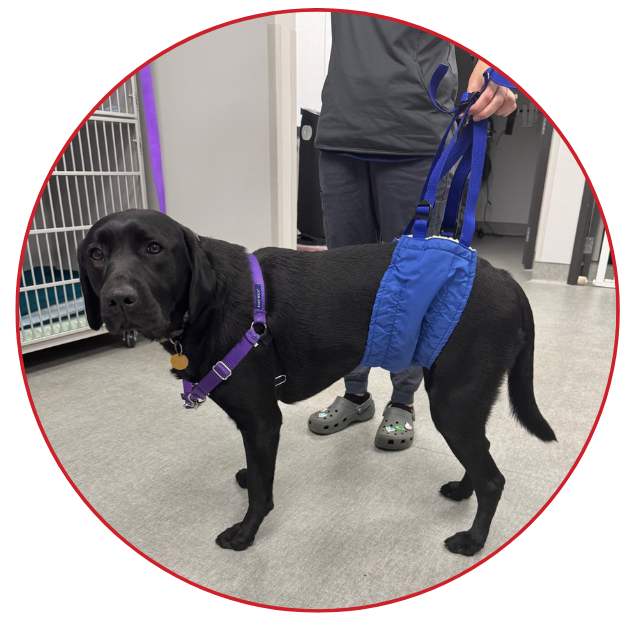In order to minimize loss of function and expedite recovery, we ask that you perform the following home exercises for your pet. Not all exercises are applicable to every patient, ask your veterinarian which exercises are best suited to your pet’s condition. All recommendations for repetitions and frequency are approximate guides and can be adapted to your pet’s personal needs.
Use Of Sling/Harness Support
If your pet has a neurological weakness, we strongly encourage the use of either a harness or sling to provide support. Even if they can bear weight, but are uncoordinated, a support device can prevent tripping/stumbling mishaps. While many different brands/configurations of support devices can be used, the Neurology Department at PVESC recommends the Help ‘Em Up® harness for overall (forelimb and hind limb support).

Passive Range of Motion (PROM)
Take each affected limb through full range of motion of each joint. This means the carpus/wrist, elbow and shoulder in the forelimb; and hock/ankle, stifle/knee, and hip joints in the hind limb. Move each joint through flexion and extension. This can either be performed on each joint individually, or as a compound movement (think of a bicycle pedaling type movement). Do not force the movement if your pet is displaying any pain. Perform 10-20 repetitions two to three times daily.

Supported Standing
With either harness or sling support, get your pet into a standing position, place the feet in an appropriate weight bearing position (not knuckled over), and remove some of the support to allow your pet to bear as much weight on their own as possible. Hold them in a standing position for 30-60 seconds, then give them a 60 second break. Perform 2-3 repetitions two to three times daily.
Three Leg Standing
With your pet in a standing position, pull one rear leg into slight flexion (off the ground) and slightly backwards, so that they are forced to bear more weight on the opposite side. Hold them in that position for 30-40 seconds, then allow them to rest for 30-60 seconds, then repeat. Perform 2-3 repetitions two to three times daily for each rear leg.
Treats at the Hip
With a treat as motivation, encourage your pet to flex their neck/trunk to each side by moving the treat to their hip. Try to have them hold the stretch for 10-20 seconds. Perform 5 repetition in both directions. This helps stretch the paraspinal muscles on the opposite side of the spine.
Paw Up
Have your pet place their front paws on a low object (stairs, stool, couch for large dogs), to shift weight bearing to the rear limbs. Hold the position for 20-30 seconds, then let them rest for 30-60 seconds. Perform 2-3 repetitions two to three times daily.
Leash Walking
When your veterinarian feels it is appropriate, you may start short leash walks. Ask your veterinarian what the appropriate duration/distance is for your pet’s needs. Be mindful that patients with neurological weakness are prone to scuffing/scraping their feet. Whenever possible walk on softer, more forgiving surfaces such as grass or packed dirt rather than cement/asphalt if they are prone to scuffing. Acquiring protective booties can be helpful to provide additional protection to the digits and provide traction for slick flooring. Check your pets’ feet daily for development of redness or sores and contact your veterinarian if either is noted.
